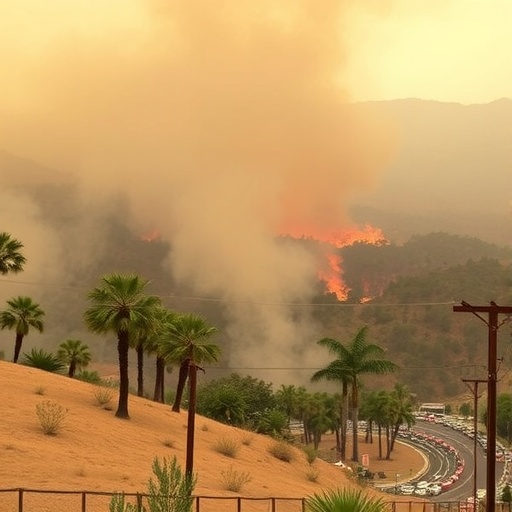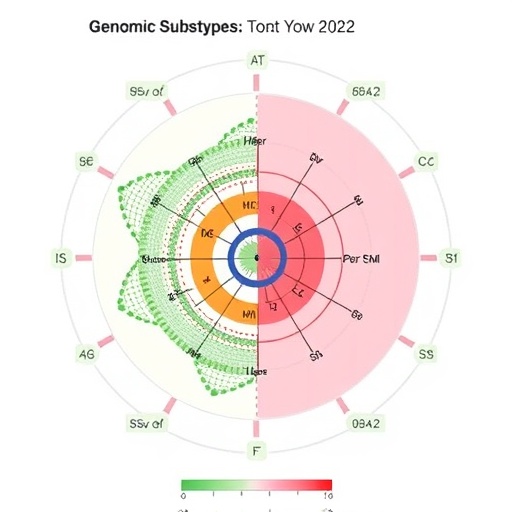In the wake of the devastating urban fires that swept through the Los Angeles area in January 2025, groundbreaking research conducted by the University of Arizona’s Mel and Enid Zuckerman College of Public Health has unveiled significant physiological alterations in firefighters exposed to these unprecedented conflagrations. Their findings, recently published in the Journal of Occupational and Environmental Medicine, expose a concerning cascade of biological changes that could elevate the long-term health risks faced by these first responders, including increased vulnerability to cancer.
The catastrophic fires, which consumed over 23,000 acres encompassing wildland-urban interfaces and dense urban regions, resulted in the evacuation of more than 100,000 residents. This unprecedented scale and intensity of exposure provided a unique but sobering context for scientists to investigate the systemic effects of extreme fire-related toxins and stressors on human health. Blood samples drawn from 42 firefighters, meticulously gathered both before and after their intense deployments, formed the basis of this observational study, offering rare insight into the molecular toll exacted by such events.
Central to the research was the detailed analysis of the serum proteome—the complex mixture of proteins circulating in the bloodstream that orchestrate critical physiological functions including immune defense, inflammatory responses, and cellular communication. The study identified alterations in 60 distinct protein expressions among firefighters post-exposure, underscoring a widespread systemic response to the environmental onslaught. These molecular changes not only reflected acute immune activation but also hinted at chronic pathological pathways with profound implications.
Specifically, pathways implicated in carcinogenesis showed marked modulation, suggesting that firefighting in extreme urban fire conditions could precipitate biochemical environments conducive to cancer development. Proteins involved in cell proliferation, differentiation signaling, and apoptotic evasion exhibited variable expression patterns, potentially laying a molecular foundation for oncogenic transformation. Equally concerning were shifts in metabolic and oxidative stress markers, indicating increased production of reactive oxygen species and resultant cellular damage—both recognized drivers of mutagenesis and chronic disease.
Another critical facet highlighted by the study was the disruption of proteins related to cellular barrier integrity. Given that robust cellular junctions are essential for maintaining tissue homeostasis and preventing pathogen infiltration, alterations in these proteins may compromise firefighter immune defenses, elevating their susceptibility to infections and inflammatory disorders. This integrative protein signature, encompassing immune, metabolic, and structural elements, paints a multifaceted portrait of firefighter health vulnerability triggered by intense fire exposure.
Melissa Furlong, the study’s lead author and an assistant professor of environmental health sciences at the Zuckerman College, emphasized the strategic rationale behind the research. By profiling broad-spectrum changes in blood protein signatures, her team intended to capture the holistic biological impact of fighting large-scale urban fires—events that pose compounded health hazards compared to isolated wildfires due to the complex mixture of urban toxins and prolonged exposure durations. These insights provide crucial early warnings about potential health trajectories for first responders.
Beyond the initial findings, senior author Dr. Jeff Burgess, a prominent figure in firefighter health research, has long collaborated with fire service professionals to elucidate the cancer risks associated with occupational exposures. His prior work on epigenetic modifications induced by firefighting stress has helped galvanize international recognition of firefighting as a carcinogenic profession. This latest study builds on that foundation, providing tangible biochemical evidence supporting ongoing efforts to mitigate health risks through improved monitoring and prevention strategies.
Importantly, the collaborative nature of this research, which engaged firefighters at every stage—from study design to data interpretation—ensures that the findings resonate with the lived experiences and concerns of those most affected. Firefighters frequently inquire about how their exposures might translate into long-term health consequences. This study offers them data-driven answers, affirming some of these fears while laying the groundwork for targeted interventions.
Looking forward, Furlong, Burgess, and their colleagues are championing longitudinal studies aimed at mapping the persistence of these protein changes over extended periods post-exposure. The goal is to discern whether certain proteins serve as reliable biomarkers that consistently respond to firefighting hazards and could be harnessed as early warning signals for disease risk. Such biomarkers would be invaluable for precision health monitoring and developing preemptive medical strategies designed to protect these frontline workers.
Furthermore, these insights could inform the design of novel protective measures or therapeutic interventions. If specific proteins are identified as key mediators in the transition from exposure to disease state, they might become targets for pharmaceutical modulation, thereby offering new avenues for cancer prevention or mitigation of other inflammatory conditions associated with firefighting.
The research team includes notable contributions from Shawn Beitel, who provides invaluable expertise in research program administration within the Firefighter Health Collaborative Research Program, Reagan Conner, an emerging scholar from the Department of Community, Environment and Policy, and Xinxin Ding, leader of the Department of Pharmacology and Toxicology at the University of Arizona’s College of Pharmacy. This interdisciplinary collaboration exemplifies the comprehensive approach necessary to tackle such complex occupational health challenges.
This pioneering study underscores the urgent need to amplify research funding and policy focus on firefighter health, especially as urban wildfire incidents are projected to increase with climate change. Enhancing our understanding of the molecular aftermath of such exposures is essential for safeguarding the health of those who risk their lives to protect communities, enabling timely interventions that could save not only their lives but also improve their quality of life post-service.
As the scientific community digests these findings, the hope remains that continued investigation and innovation will yield diagnostic tools and preventive protocols capable of stemming the tide of disease linked to firefighting exposures. For now, the work of Furlong, Burgess, and their team offers a clarion call to recognize and address the insidious health challenges posed by the convergence of urban conflagrations and frontline human resilience.
Subject of Research: People
Article Title: Changes in Serum Proteins in Firefighters Responding to the 2025 Los Angeles Urban Conflagrations
News Publication Date: 14-Oct-2025
Web References:
University of Arizona Mel and Enid Zuckerman College of Public Health
Fire Fighter Cancer Cohort Study
Journal of Occupational and Environmental Medicine
DOI Link
Image Credits: Photo by Kris Hanning, U of A Office of Research and Partnerships
Keywords: Cancer risk, Immune system, Blood cells, Personal protective equipment, Fire, Blood serum
Tags: cancer vulnerability in firefightersenvironmental toxins and firefightersfirefighter blood protein changesLA-area wildfires health impactsoccupational health and safetyphysiological effects of wildfiresproteomic analysis in health studiespublic health research on wildfiressystemic effects of fire exposureurban fire health researchwildfire exposure health riskswildfire first responders health





